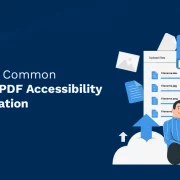
5 Ways to Deliver Application Training and Improve Employee Efficiency
Table of Contents:
- Introduction
- What is application training?
- 5 Ways to Establish Robust Application Training
1. eLearning
2. Gamification
3. Mobile Learning
4. Video Content
5. Blended Learning - How to Pick the Best Delivery Method?
- Final Thoughts
Introduction
In an episode of the Joe Rogan Experience podcast, Andrew D. Huberman, a renowned neuroscientist, had an insightful take on learning new things in adulthood. He explains that gaining new knowledge and skills is linked to neuroplasticity, which is a lot easier when you’re younger.
However, that process can be triggered in adulthood, if you can:
- Be in a high-focus zone
- Create a sense of urgency
If you can achieve these two things, starting a new role in the existing workplace or a different one will not seem intimidating. Considering the fast-paced nature of today’s business world, more and more companies are making application training a priority.
The expenditure on corporate training increased by 15% in 2020 strengthens this fact. Besides, 53% of respondents in that study by Deloitte indicated that at least 50% of their existing workforce would need to acquire new skills in the next three years.
Even so, most organizations fail to trigger the learning process, as described by Andrew Huberman. It’s the execution that lacks and not the intention. According to a report by CIPD, UK, nearly 20% of organizations fail to leverage technology to promote learning activities. Many of them continue to depend on conventional classroom-based software application training.
Even though the report emphasized the importance of using emerging tech to support employee training, only a handful of organizations do so. If you’re considering moving away from old training methods, now is the time!
What is Application Training?
Thanks to the advent of robotics, machine learning, and artificial intelligence, organizations are using advanced training modules to upskill their employees. Application training allows your workforce to adapt to changing trends.
By conducting application training at the organizational level, you can greatly enhance the employees’ productivity while improving their employability. Begin by identifying the skills that are most valuable for your company’s future and devise a strategy to train them to use the relevant employee training applications and software effectively.
5 Ways to Establish a Robust Application Training System and Improve Employee Efficiency:
1. eLearning
eLearning is one of the best ways to engage employees and ensure an effective employee training method. It is delivered through smartphones, tablets, and computers. The flexibility to learn anytime, anywhere has led to its soaring popularity in recent years.
A recent report published by LinkedIn says that about 57% of L&D professionals anticipate spending a lot more time on eLearning. Companies such as Tesco have benefited a lot from online learning as they have a huge workforce to train and manage.
Using bite-sized interactive modules, they successfully delivered global compliance training. Since eLearning is supported by advanced analytics, managers can figure out who needs more encouragement to complete the training.
As a result, Tesco accomplished an incredible 98% completion rate. On top of that, nearly 92% of their employees enjoyed this training method compared to others.
2. Gamification
When it comes to engaging your employees, Gamification is a sure-fire way of increasing their efficiency. Using game mechanics, they can solve problems, innovate, learn new skills, and modify their behavior. Basically, Gamification is mLearning (mobile learning) and eLearning training courses translated into a game.
To make it successful, you must set the right learning outcomes. For instance, employees can play games containing elements such as unlocking new information, accruing points, or beating the clock.
Hurix offers a wide range of eLearning and training solutions, including Gamification, to boost the growth of your business.
3. Mobile Learning
Essentially, mLearning or mobile learning is an eLearning module that can be delivered through handheld devices. Nowadays, most employees are tech-savvy, so the significance of mobile learning cannot be ruled out. Since mLearning courses can run on portable devices, employees have the flexibility to take them anywhere.
Most Mobile Learning courses have a series of 10-minute lessons given the short attention span of most users. Ensuring that each employee must have a computer is a bit difficult. However, most of them have portable devices, and when such constraints are removed, employees feel motivated to complete the application training.
For instance, Merrill Lynch delivered their employee training program through mLearning. An astounding 100% of their employees favored it for future training programs.
4. Video Content
If you want to create a highly effective training problem, be sure to include videos in it. For starters, it’s way more engaging than only text-based content. Besides, employees can choose to pause, watch the video later or rewind and watch something they may have missed.
Such flexibility not only encourages learning but acknowledges the fact that all humans are not built equal. Depending on what engages them and their attention spans, videos can be an effective storytelling medium.
Videos are also cost-effective since they don’t incur recurring costs. You can watch them over and over again. You can leverage videos to teach core aspects of their job role, outline your company policies, and explain your organization’s culture.
5. Blended Learning
You don’t have to pick just one method to boost your employees’ efficiency on various applications. You can, instead, go for a blended learning program where you can combine the best features of all training methods. An example should make it clearer for you.
As you may have observed, certain training formats like mLearning and eLearning are intertwined. Why not create an eLearning module that would serve as the main content vehicle and use Mobile Learning modules to offer on-demand information access, specific learning materials, advice, learning feedback, and support?
Hence, you can always take the hybrid approach to train your employees.
How to Pick the Best Delivery Method?
In the end, what you choose depends largely on the required features, intended purposes, available budget, and your target audience. For instance, if your employees are required to travel frequently, they may not find the uninterrupted or consistent time to upskill themselves. In such a scenario, mLearning could be their best bet.
Apart from that, it would help if you consider the following parameters to select the best application training delivery method:
- Identify your long-term and short-term organizational goals
- Establish your key performance indicators
- Think about which strategy would motivate employees
- Analyze which training format would be convenient for them
- Determine if the existing training methods would integrate well with the format of your choice
Final thoughts
You can choose any of the five training delivery methods or a combination of them to boost employee efficiency. However, if you’re still unsure, you can always test the training format of your choice on a representative group of employees first and then roll it out for the entire organization.
Employees value the fact that their organization takes their professional development seriously. Training your employees on various applications will improve their efficiency in operating the different tools and software, and help them grow their skill sets and deliver better results.
Need to know more about our Products & Services? Drop us a Note.

Senior Vice President
A Business Development professional with >20 years of experience with strong capability to sell new solutions and develop new markets from scratch. New Market Entry Specialist with experience of working in two of the largest emerging markets – China & India. Also covered other key markets in APAC, US, EU & ME. Exceptional experience of conceptualizing, ideating and selling new learning technologies like VR AR, etc. across multiple industry verticals.







